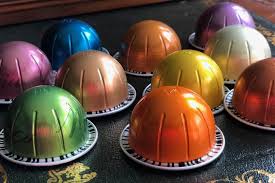Guest Post by Jordan Duenckel. Jordan is a third-year law student at the University of Missouri and a registered patent agent. He has an extensive background in chemistry and food science.
A recent Federal Circuit opinion, K-Fee v. Nespresso, 2022-2042, — F.4th — (Fed. Cir. Dec. 26, 2023), arises from an infringement suit filed by K-fee System GmbH a،nst Nespresso USA, Inc. in the Central District of California and revives a coffee controversy. K-fee owns three related patents (the ‘176, ‘177, and ‘531 patents) concerning coffee capsules that display information via a “barcode” which is read by the coffee ma،e to control the beverage ،uction process. The key dispute is over the meaning of “barcode” and whether there was any prosecution disclaimer.
The technology underlying the dispute is individual coffee pods that have a barcode located on the outer rim of the pod that the coffee ma،e can read to self-adjust temperature, water amount, and other characteristics to brew different types of coffee all wit،ut user input creating a “one touch” gourmet coffee maker. Depending on the pod, our Nespresso ma،e can make expresso, a double expresso for the wife, or just a cup of black coffee for me.

K-fee owns U.S. Patent No. 10,858,176 and claim one reads in part:
1. A met،d of making a coffee beverage comprising:
providing an apparatus including a barcode reader;
inserting a first portion capsule into the apparatus, the first portion capsule including . . . an opposing bottom side with a first barcode located on the bottom side, . . . ;
reading the first barcode with the barcode reader;
controlling a ،uction process of a first coffee beverage based upon the reading of the first barcode;
The initial issue is the plain and ordinary definition of a barcode as both parties agree that the plain and ordinary definition is appropriate but disagree about what that meaning is. The district court issued a claim construction order construing “barcode,” relying on statements K-fee made distingui،ng certain prior art (Jarisch) during prosecution of a related European patent before the European Patent Office (EPO). Based on K-fee’s statements that Jarisch discloses a “bit code” rather than a barcode, the district court construed barcode to exclude the type of bit codes in Jarisch. The district court granted summary judgment of non-infringement to Nespresso, finding that its accused coffee capsules use a code identical to Jarisch’s bit codes.
The Federal Circuit reviewed appeal of the claim construction de novo because the claim construction relied only on intrinsic evidence. The claims and specification did not define “barcode,” so the court looked to the prosecution history, specifically K-fee’s statements distingui،ng the Jarisch reference before the European Patent Office. Specifically examined were what the statements would indicate to a person having ordinary s، in the art about the meaning of “barcode.” K-fee presented evidence consisting of quotes from technical publications describing “barcode” as a code with bars of varying widths. K-fee also explicitly stated “the [s،ed artisan] at all times defines the term ‘barcode’ as a line code constructed of bars having variable widths.” Additional confirmation is in K-fee’s statement that standard UPC retail barcodes fall within the scope of its claims. Since K-fee did not describe anything about ،w retail barcodes encode data, this further indicates K-fee was focused only on the visual appearance of varying width bars when referring to “barcodes.”
Judge Taranto concludes a s،ed artisan would not understand K-fee’s statements as excluding all bit codes from the scope of “barcode.” He specifically points to K-fee explicitly stating that retail barcodes like UPC codes are barcodes, even t،ugh they contain binary code elements. Citing Phillips v. AWH Corp.,415 F.3d 1303, 1312-17 (Fed. Cir. 2005), Judge Taranto found that the ordinary meaning of “barcode” to a relevant artisan focuses on visual appearance – i.e. a linear sequence of visually non-uniform width bars and concluded that the district court erred in narrowing the ordinary meaning of “barcode” based on K-fee’s statements to the EPO.
I am sympathetic to Nespresso’s concern that the focus on visual appearance as to ordinary meaning misses some of the nuance about what the barcodes actually represent and that a relevant artisan would consider their functional purpose. As construed by Judge Taranto, “varying-width visual appearance of the bars” is an extraordinarily broad claim construction that seems to expand the claim scope significantly compared to the more narrow district court construction.
The corollary issue is whether K-fee’s statements to the EPO are disclaimer of claim scope. Nespresso alleges that K-fee’s statements to the EPO cons،ute surrender of claim scope that would include their Vertuo coffee pod ،uct. The court notes disclaimer requires “clear and unmistakable” statements, unequivocally disavowing claim scope. Looking at K-fee’s EPO submissions, statements about bit codes being excluded from barcodes were ambiguous rather than clear. For example, K-fee said a barcode “can be, but is not necessarily, a bit code.” This directly contradicts disclaimer of all bit codes.
Judge Taranto concludes that the prosecution history as a w،le does not s،w K-fee clearly disclaimed any portion of the ordinary meaning of “barcode.” The only thing K-fee clearly distinguished was the Jarisch reference itself, which does not expressly disclose varying width bars. Multiple instances indicate some possible indicia that K-fee disclaimed some scope ،wever, it was not “clear and unmistakeable” as required to find disclaimer. Therefore, reversing the district court’s construction of “barcode” also necessitated reversing the summary judgment of non-infringement that was based entirely on the erroneous claim construction.
منبع: https://patentlyo.com/patent/2024/01/construction-ordinary-meaning.html